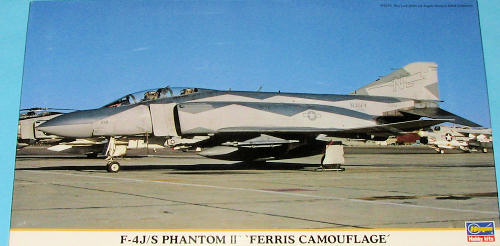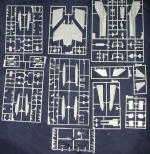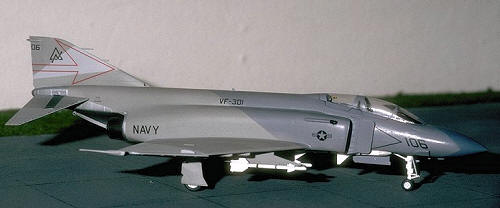
Hasegawa 1/72 F-4J/S Phantom II 'Ferris Camouflage'
| KIT #: | 00911 |
| PRICE: | $42.50 SRP |
| DECALS: | Two options |
| REVIEWER: | Scott Van Aken |
| NOTES: | Limited Reissue |

| HISTORY |
| THE KIT |
 This is a late 2008 reissue and to be honest, there are no additional bits and pieces from a standard F-4J/S Phantom II kit. I bought this one from a vendor's table where I couldn't pass up the price and just had to add it to my Phantom pile. Actually, like most of you, I'll never get around to building them all, but there is something about them that I like. My luck, Tamiya will come out with one that builds in a quarter the time, but until then, these are the best Phantoms available in this scale.
This is a late 2008 reissue and to be honest, there are no additional bits and pieces from a standard F-4J/S Phantom II kit. I bought this one from a vendor's table where I couldn't pass up the price and just had to add it to my Phantom pile. Actually, like most of you, I'll never get around to building them all, but there is something about them that I like. My luck, Tamiya will come out with one that builds in a quarter the time, but until then, these are the best Phantoms available in this scale.
Thekit was state of the art in 1990 and still holds up very well. All the partshave engraved panel lines, which is the expected norm, and there are lots ofthem. In fact, many think that these multi-version kits are a bit too intricatewith too many parts. In several ways, I must agree. The greater the number ofparts, the greater the chances of messing something up! However, it is the mostcost effective way for Hasegawa to produce multiple versions of an aircraft,otherwise the additional tooling cost would have to be passed along to theconsumer.
Hasegawa cockpits are usually devoid of sidewalland instrument panel detail in 1/72 and this one is no exception. Theinstruments and side console detail is provided by a decal and that is adequatefor this scale. Also typical of Hasagawa kits is that there are no externalstores beyond the wing and centerline drop tanks. For these items, you need tobuy the Hasegawa weapons sets, an additional expense.
All of thesprues, including the clear bits are packed together in a single clear bag.Drawback of this is that by the time the modeler gets the kit, the parts are allwell scratched by rubbing against each other during shipment. Other kit makersuse multiple bags to prevent this damage. Why Hasegawa still does not do this isbeyond me.
The only real option on the kit is for open or closedcanopies. Missing are the canopy actuating arms that hold the canopies open. Thekit also has no provisions for lowered slats, speedbrakes or flaps. Phantoms onthe deck are often seen with drooped flaps or speedbrakes.
 Instructions are typical of later Hasegawa kits. It has 15 construction steps and an excellent paint guide using Gunze Sangyo paints. FS 595 numbers are given where needed. There is also a weapons load chart showing you where to put
Instructions are typical of later Hasegawa kits. It has 15 construction steps and an excellent paint guide using Gunze Sangyo paints. FS 595 numbers are given where needed. There is also a weapons load chart showing you where to put what weapons. Markings are for two planes. One is the F-4J from VF-194 that wore the scheme you see on the box photo. The other is from VF-301, a reserve unit that flew the F-4S and used a different style of scheme with different colors. Though not a Hasegawa kit, this is the scheme painted on a Fujimi kit many years back. It isn't identical to the kit option as the colors were transposed on each of the planes in VF-301 that were so painted. The decal sheet is well printed and includes the false canopy needed for the VF-194 option.
what weapons. Markings are for two planes. One is the F-4J from VF-194 that wore the scheme you see on the box photo. The other is from VF-301, a reserve unit that flew the F-4S and used a different style of scheme with different colors. Though not a Hasegawa kit, this is the scheme painted on a Fujimi kit many years back. It isn't identical to the kit option as the colors were transposed on each of the planes in VF-301 that were so painted. The decal sheet is well printed and includes the false canopy needed for the VF-194 option.
| CONCLUSIONS |
November 2009
If you would like your product reviewed fairly and fairly quickly, please contact the editor or see other details in the